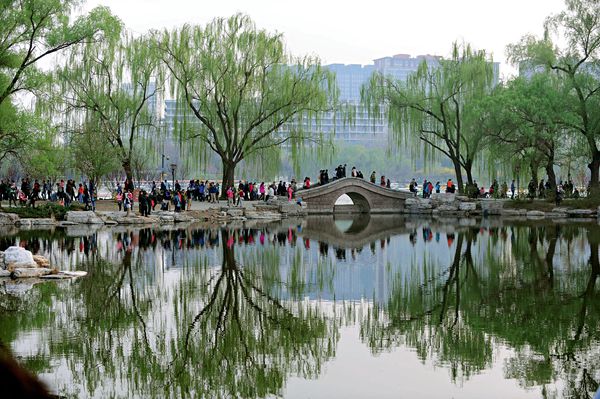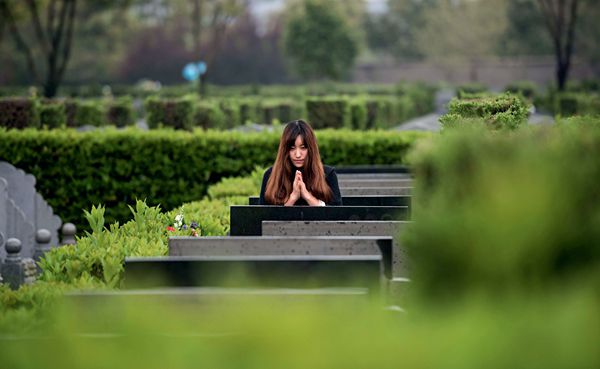THIS poem is among the best known of Chinese depictions of Qingming Festival, also known as Tomb-Sweeping Day. Du Mu’s (803-c.852) lines evoke the weather typical of the season and also its distinct ambience, as people clean the tombs of deceased relatives and hold ceremonies to honor their ancestors.
Qingming refers to a solar term on the Chinese lunar calendar as well as a festival. Through continuous centuries of farming practices, ancestors of the Chinese people discovered the close ties between agriculture and climate. To explain the relationship between the Sun and the Earth, they divided the year into 24 parts to indicate the changes and characteristics of different seasons. Qingming, literally meaning pure brightness, is the fifth of the 24 seasonal division points and usually falls around April 4 or 5 (or the beginning of the third month of the lunar calendar). This year, it falls on April 4. At the onset of spring when the temperature rises and everything comes back to life, Qingming is the ideal time to plough and sow.

People most enjoy going on outings at the Qingming Festival as it is at the onset of spring.
Qingming is associated with tomb sweeping and ritual offerings. With a history of over 2,500 years, this day, also an occasion on which to honor ancestors and go on spring outings, is one of the most important traditional Chinese festivals. In China it is considered, along with the Zhongyuan and Hanyi festivals on the 15th of the seventh lunar month and the first of the tenth lunar month respectively, a festival of spirits. In 2006, the Qingming Festival was granted National Intangible Cultural Heritage status by the State Council.
This is a day that blends the traditions of the Cold Food Festival and the Shangsi Festival in which people consume cold food and go on outings. Before the seventh century, the Cold Food Festival and Qingming were celebrated in succession but with different objectives. The former, to mourn the deceased, took place one or two days before the latter, with people praying for renewal and protection of life. Showing their respect for both life and death, the two events complemented each other.
The Cold Food (or Hanshi) Festival dates back to the Spring and Autumn Period (770-476 BC) in memory of Jie Zitui, a senior official loyal to the Jin State. The use of fire was forbidden to express tribute. Therefore, foods were prepared in advance and served cold during this period. Different regions in China serve different dishes during this festival. In the north, people usually eat swallow-shaped steamed cakes made of flour and dates, named after “Zitui Swallows.” In the south, sweet rice balls are the customary treat. This steamed dessert is made with sticky rice flour and bromegrass juice filled with date or red-bean paste.

Qingming Festival is also known as Tomb-Sweeping Day.
Tomb sweeping constitutes an important part of the Cold Food Festival. Honoring ancestors was essential in ancient China, a tradition dating back to the third century BC. In the Tang Dynasty (618-907), the sweeping of tombs during the Cold Food Festival was considered the requisite ritual to commemorate ancestors. Emperor Xuanzong (685-762) issued an order during his reign, stipulating the folk ceremony of cleaning tombs as a fixed Cold Food Festival ritual. Since Qingming comes right after the Cold Food Festival, such tomb-sweeping rituals came to be deferred little by little toward Qingming.
During the Song and Yuan dynasties (960-1368), Qingming, once linked with the Cold Food Festival, gradually replaced the latter. Rituals to commemorate ancestors were held during Qingming, along with such customs of the Cold Food Festival as eating cold food, playing soccer, and reveling on swings.
What is more, some of the customs of the time-honored Shangsi Festival could also be observed in the Qingming Festival. Celebrated on the third day of the third lunar month, the Shangsi Festival offered a chance for people to go on spring outings and bathe in rivers in hopes of purging misfortune. As winter turns to spring, people yearn to be closer to nature in the wild. In the Tang Dynasty, a tradition took shape of going on outings along with cleaning tombs, which were usually in the countryside. Hence, it became a good time to enjoy the splendors of spring after commemorating ancestors.
During the Song and Yuan dynasties, Qingming Festival merged the customs of the other two festivals, which after the 14th century were gradually celebrated less and less. Qingming consequently became a major spring event. On this day, people clean the tombs of departed relatives, honor ancestors, and then enjoy the beautiful scenery while joining in such recreational activities as soccer, swings, and flying kites. Thus, sad tears and joyous laughter intermingle, giving the festival a peculiar ambience. The famous painting Qingming Festival at the Riverside by Zhang Zeduan (1085-1145) portrays festive scenes along the banks of the Bianhe River in Bianjing (today’s Kaifeng in Henan Province), the capital city of the Northern Song Dynasty (960-1127).
